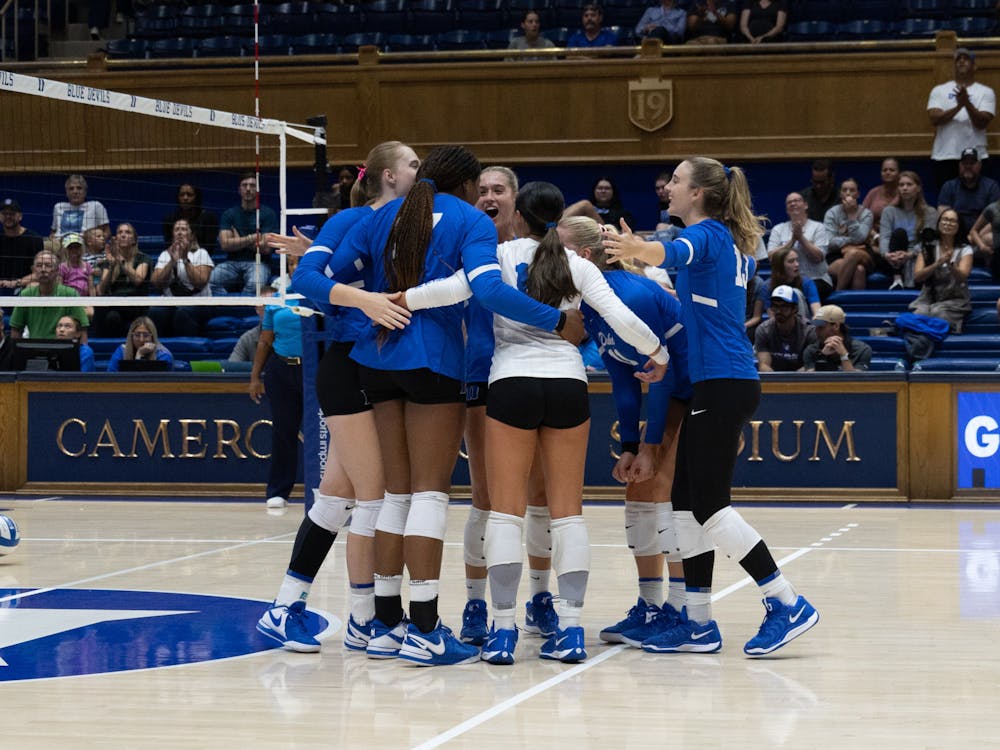With the fall sports season underway, The Chronicle is here with a breakdown of every sport, including key rules, terminology, tournament formats and more. Up next is an explainer on volleyball.
Overview
Indoor volleyball is typically played on a hardwood surface; Duke volleyball plays in Cameron Indoor Stadium! Each team plays in a square of 29 feet, 6 inches in width, equivalent to 9 meters in the picture below. The two sides are separated by a net with a height slightly more than 7 feet. Each end of the net is affixed with a tall rod marking the playing boundary.

Rules
Players: There are six players on either side of the court at any given time. Players rotate positions and the serve order is in a clockwise circle. One player, the libero, is a designated defensive player and does not rotate to the front beside the net; they wear a different color uniform.
Scoring: A match is won when a team wins three sets. A set is awarded to the first team to 25 points by at least a two-point margin. If a fifth set is necessary, it is played to only 15 points.
Playing a point: A point starts when a player serves the ball from behind the playing area over the net to the other team. Once the ball is in play, each team may touch it only three times — excluding a block — before hitting it over the net to the other team. The ball may not touch the floor.
Winning a point: A point is won when the opposing team fails to get the serve or shot over the net, allows the ball to hit the floor, hits the ball out of the playing area or touches the ball more than three times. Additionally, the team wins a point if one opponent touches the ball twice consecutively or if the ball hits the out-of-bounds rod at either end of the net. A point may also be awarded when the opposition receives a penalty for illegal actions such as touching the net, “lifting” the ball (making prolonged contact) or stepping into the playing area during a serve.
When a team wins a point, they also win control of the ball and will serve to begin each point until they lose a point, which is when the opposing team will take control of the ball.
Terminology
Set: A type of touch in volleyball where a player hits the ball directly upwards in front of the net to allow another player to spike the ball. A set also refers to the scoring format for the sport, and if a team wins three of five sets, they win the match.
Assist: An assist is awarded to a player when they successfully set a ball that results in a kill from a teammate.
Attempt: This occurs when a player hits an offensive shot into the opponent’s court.
Dig: A dig is awarded to a player when they successfully defend against an attempt by the opposition.
Kill: A kill is awarded to a player when their offensive shot is unable to be returned by the opposing team and directly results in winning a point.
Block: This is the action of stopping or deflecting the ball coming from the opponent's side, usually by jumping in the air near the net.
Get The Chronicle straight to your inbox
Sign up for our weekly newsletter. Cancel at any time.
Ace: An ace is a serve that is unable to be returned by the opposing team and directly results in winning a point.
Error: An error is recorded whenever a player’s attempt goes out of bounds, into the net or is blocked down by the opposing team.
Positions:
-
Libero: The libero is the key defensive player; they are assigned to stay in the backcourt. They have priority when receiving serves and kills and wear a different colored jersey.
- Duke’s starter: Mailinh Godschall
-
Outside hitter: The outside hitters are the main attackers on the side of the court where their dominant hand is towards the middle.
- Duke’s starters: Kerry Keefe, Taylor Williams and Rachel Richardson
-
Middle blocker: The middle blockers stay in the frontcourt near the middle of the net and often notch the most blocks. They are also often high-efficiency attackers.
- Duke’s starters: Rylie Kadel and Breonna Goss
-
Defensive specialist: This is an important rotational player focused on defense; they’re able to sub in or out any player on the court.
- Duke’s starter: Nikki Underwood
-
Setter: The setter controls the offense and distributes the ball.
- Duke’s starter: Grace Penn or Nikki Quinn
Season format
Duke has started its season with three out-of-conference tournaments, hosting two of them and traveling to Penn State for another. It hosts one final Big 10/ACC challenge with matchups against Michigan and Michigan State. During conference play, the Blue Devils will play 20 matches against conference opponents, 10 at home and 10 away. There is no conference tournament; the ACC champion will be determined by the best record at the end of the regular season.
Coaching staff and recent trends
Duke is led by head coach Jolene Nagel, who is in her 25th season with the team. Nagel is one of 22 NCAA volleyball coaches to have at least 600 career wins, and has 503 wins in her Duke tenure.
Duke finished last season with a 19-10 record, its best in recent memory. Graduate student star Gracie Johnson was the driving force between the team’s success last year, and this season’s group is a younger but still talented squad. Kerry Keefe earned All-ACC second-team honors last season and figures to be the team’s on-court leader. Keefe is one of five captains, joined by Millie Muir, Kadel, Richardson and Underwood.
Click here for The Chronicle's beginner's guide to every sport.

